The Great Underwear Shift

A few months ago, Bloomberg reported on how thoroughly the relatively new-fangled boxer brief had infiltrated men’s pants, which have grown too form-fitting in recent years to stuff baggy boxer shorts into:
Boxer briefs — with the length of traditional boxer shorts and the form-fitting profile of briefs — are the overwhelming national favorite, laying claim to nearly 40 percent of the $2.7 billion U.S. men’s underwear market, according to data from NPD Group. The style has continued to gain ground as men abandon loose underwear in favor of slimmer, more secure undies. Boxer briefs have “become the expected product, rather than the experimental one,” says NPD’s Marshal Cohen. “It started out as very avant-garde — a statement piece. … The shock factor of what it was, and why it was, is gone.”
Yesterday, the New York Times argued that an analogous shift — though, one that is not nearly as widespread — is happening in women’s underwear, from thongs to “full-bottom bikinis, boy shorts and high-waist briefs”:
“Within millennial and Generation Y consumer groups, it’s considered cool to be wearing full-bottom underwear,” said Bernadette Kissane, an apparel analyst at the market intelligence firm Euromonitor. “Thongs have had their moment.”
Data provided by the research company NPD Group back her up. Sales of thongs decreased 7 percent over the last year, while sales of fuller styles — briefs, boy shorts and high-waist briefs — have grown a collective 17 percent.
For the first time in decades, in other words, the silhouettes of men’s and women’s underwear, which, during peak thong and peak boxer shorts, were highly divergent, have re-aligned: full, form-fitting, slimming coverage for both sexes. There is probably a cultural anthropologist who can more readily explain the precise causal relation between underwear styles, gender dynamics, and geopolitics, but the last time everybody wore the basically same underwear, Reagan was in office.
